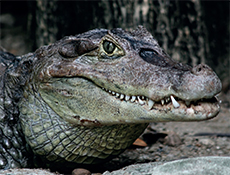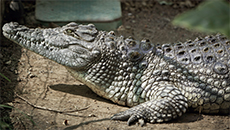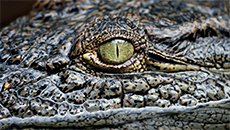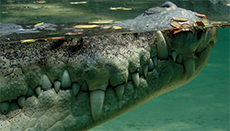




| Home | Features | Club Nights | Underwater Pics | Feedback | Non-Celebrity Diver | Events | 27 April 2024 |
| Blog | Archive | Medical FAQs | Competitions | Travel Offers | The Crew | Contact Us | MDC | LDC |

|

|
 
 |
    ISSUE 18 ARCHIVE - CROCODILESDr John CarlinRow row row your boat......gently down the stream. If you see a crocodile don’t forget to screeeeeammmmmm! The ‘ruling reptiles’The word ‘crocodile’ is derived from the ancient Greek word crocodilus which means lizard. However this is a bit misleading as crocodiles are genetically closer to birds and dinosaurs than lizards. Crocodiles belong to a sub-class called the Archosaurs which includes birds and dinosaurs. The Archosaurs are known as the ‘ruling reptiles’ and scientists believe that the ancestral members of this group originated in the Triassic period 250 million years ago. Crocodiles themselves are thought to have appeared first in the Ecocene era about 55 millions years ago and have changed very little in the last 20 million years. Appearances can be deceivingDespite appearances crocodiles are one of the most biologically complex reptiles and are more similar to mammals and birds. They are the only reptile to have a four chambered heart (two atria and two ventricles) and possess a functional equivalent of a diaphragm. A set of muscles attached to their pubis bone, liver and diaphragm that create a piston-like system which pulls the diaphragm towards their tail, enlarging their chest cavity and drawing air into their lungs. A successful predatorCrocodiles spend most of their time in freshwater throughout the tropics. Although not particularly agile on land they swim almost effortlessly and are capable of demonstrating real agility and speed in water. Crocodiles have evolved several physical traits that make them amazing aquatic predators. They have five webbed toes on their front limbs and four on their hind limbs which they use to initiate swimming before tucking them into their streamlined body where their powerful tail takes over to propel them through the water. Their webbed feet are also used when they hunt to make fast and sudden turns. Crocodiles have a rigid bit of tissue (palatal flap) at the back of their mouths which blocks the entry of water. This enables the crocodile to open it’s mouth underwater when capturing prey. The scales of a crocodile have pores which scientists believe have a sensory function. However, the exact function of these pores has yet to be determined. Those found on the upper jaw, nose, around the eyes, lower jaw and upper palate are believed to be mechanoreceptors which sense pressure changes alerting the animal to prey swimming past. The strongest bite of any animal in the worldCrocodiles have evolved powerful jaws to clamp on to their prey. The pressure of its bite is 30,000kPa; more than a great white shark (2,800kPa). They have powerful muscles to close their jaws and sharp teeth to tear and hold onto the flesh of their prey. They are cold-blooded predators with a slow metabolism enabling them to go long periods between meals. They will eat fish, birds, mammals and even smaller crocodiles. Surprisingly, they have a very weak sets of muscles to open their mouths, so they can be subdued by just ‘taping’ their jaws shut which is used if they have to be transported and/or studied. Normally observed on the edge of river banks with their mouths open they can be seen panting like dogs. This is because crocodiles do not have sweat glands and release heat through their mouths and will even sleep with their mouths open. How big and old can they get?Measuring the age of a crocodile is notoriously difficult. The most common method is to measure the growth rings which can be seen in their teeth (which reveal the dental growth between dry and wet seasons). Size varies greatly between the crocodile species. The smallest of the crocodiles is the dwarf crocodile which grows to an average of 1.5 metres and weighs in at about 80kg. The largest is the saltwater crocodile reaching up to 6 metres and weighing more than 1,000kg. Scientists believe the bigger the species the longer they live. The saltwater crocodile is estimated to live for around 70 years and there is evidence of some individuals exceeding 100 years. In and out of waterCrocodiles are very fast over short distances in and out of water. Out of water they have three styles of locomotion: The ‘high walk’(lifting its body from the ground) is the slowest form of movement on land (2-5kph) and is believed to be performed when crossing rough ground or raised obstacles. The ‘belly crawl’(like a lizard with it’s legs splayed out) is the most common way for crocodiles to move around on land and is usually slow but can be modified so they can move up to 5-10kph. The gallop is used by crocodiles to escape potential danger and certain species can reach almost 20kph over short distances of 15-20 metres. Swimming and gastroliths...Crocodiles are far more suited to being in the water. Using their powerful tail they can cruise in the water at speeds up to 30-40kph. As ambush predators, they wait for fish or land animals to come close and then attack. Sometimes they use a technique known as the ‘death roll’ to drag large prey into the water and use their own body weight to roll over and over until their victim is drowned. The classic crocodile pose is where the head is at the surface and its body angled downwards a few centimetres below the surface. This is achieved by the crocodile having a certain amount of air in its lungs to counteract its weight and using its limbs splayed out to stabilise it from rolling over. To dive, the crocodile simply exhales just enough to adjust its buoyancy and slowly disappear beneath the surface. Crocodiles have gastroliths otherwise known as ‘stomach or gizzard stones’. A gastrolith is a rock held inside the gastro- intestinal tract which crocodiles use, not only to grind up food, but also as ballast to help them sink. At the bottom of the river or pond, crocodiles usually walk around. They use their buoyancy to ‘bound’ over rocks and plants. When the crocodile has to move quickly it starts to swim using its tail. Dive timeReports suggest that crocodiles can potentially dive for up to two hours, although the average time is ten to fifteen minutes. Their blood has a remarkable affinity to carry oxygen and whilst diving the crocodile will reduce its heart beat and use valves in its heart to redirect blood to essential areas to reduce oxygen consumption. Crocodile sexAfter mating the female chooses a stretch of shoreline and makes a nest of mud and vegetation built above the waterline so that it will not flood. She will lay eggs which can range anywhere from 25-90 depending on the species, age and size of the crocodile. The sex of the hatchlings is not determined by X and Y chromosomes but by the average temperature during the middle third of their incubation period. If the temperature of the nest is between 31.7 and 34.5 degrees celcius, then the offspring are born males. Above or below this narrow temperature band then they will be born females. The average incubation period for saltwater crocodiles is about eighty days. She is an attentive mother and will guard the nest until the eggs hatch. Using an egg tooth on the end of their snout the baby crocodiles break out of their eggs in a process called ‘pipping’. The egg tooth is actually a tough bit of skin which is re-absorbed less than two months after they hatch. The expectant mother upon hearing the chirping calls of her babies as they hatch will dig into the nest and help free them. She will delicately help them out of their shells and carry them in her mouth to the water. She will remain close to her offspring for several months to help protect them from being eaten by predators and bigger crocodiles. Despite this, only about 1% will survive to adulthood. How dangerous are crocodiles?Unfortunately crocodile attacks are common in places where the habitats of large crocodile species overlap with human populations. Only six of the twenty-three species of crocodiles are believed to be dangerous to adult humans. The two species with the most documented attacks are the Nile crocodile (found in Africa) and the saltwater crocodile (found in the Indo-Pacific regions). Scientists estimate that the Nile crocodile alone could be responsible for 275-745 attacks a year (with a 63% fatality rate) and the Saltwater crocodile responsible for about 30 attacks a year (with a 50% fatality rate). The numbers of crocodiles killed annually by humans is thought to be around 5,000. Their skin is considered to be one of the finest animal hides being both soft and durable and in many tribes it is seen as a symbol for high status. Many of the 23 species of crocodiles are considered ‘threatened’. Diving with a crocodileReturning from diving with crocodiles, Professional photographer Jason Brown (http://bardocreative.zenfolio. com) said:- “Meeting a live crocodile in open water isn’t an experience that most divers can add to their logbooks. For most, it’s the stuff of nightmares but for us, it proved to be an exhilarating experience that none of us who were in the water that day will ever forget. Our party of four had just returned from a cave dive at the Car Wash Cenote just north of Tulum in Mexico, when we spotted the predator floating on the surface of the head pool in the distance. Most sane people would have quietly exited the water but not us – we wanted to get close to this magnificent animal. In truth, our crocodile wasn’t of a size that would pose us any real threat but its presence still conjured up the same deep, primeval fears that most of us feel around such an animal. As we approached the crocodile from below, we suspected that our bubbles would cause the animal to take flight but our toothy acquaintance seemed unphased. Even as we circled below it and came within inches of the surface, the young crocodile ignored us as we snapped off photo after photo. Our guide, Aure, had dived Car Wash many times and knew that a crocodile had often been sighted near the water’s edge but even for him this was a first – our toothy friend showed no fear or aggression towards us and was quite happy to share the pool with us. Being in the water with this magnificent animal was a truly humbling experience for us all. Whilst our scaly friend was still very much a juvenile in crocodile terms, the experience was no less thrilling. We divers love sharing stories and this is one that I know I’ll be talking about for years to come.” See his encounter on YouTube. FUN FACT #1 Did you know that a crocodile is rubbish at pulling funny faces? Why? Crocodiles cannot stick their tongues out due to a membrane which holds the tongue in place. FUN FACT #2 Saltwater crocodiles are known to cross large areas of open sea by surfing ocean currents, hence their name. FUN FACT #3 Crocodiles have two sets of eyelids. Crocodiles can see underwater due to an inner set called the ‘nictitating membrane’. This is a clear eyelid which allows the crocodiles to see well underwater and protects their eyes. |